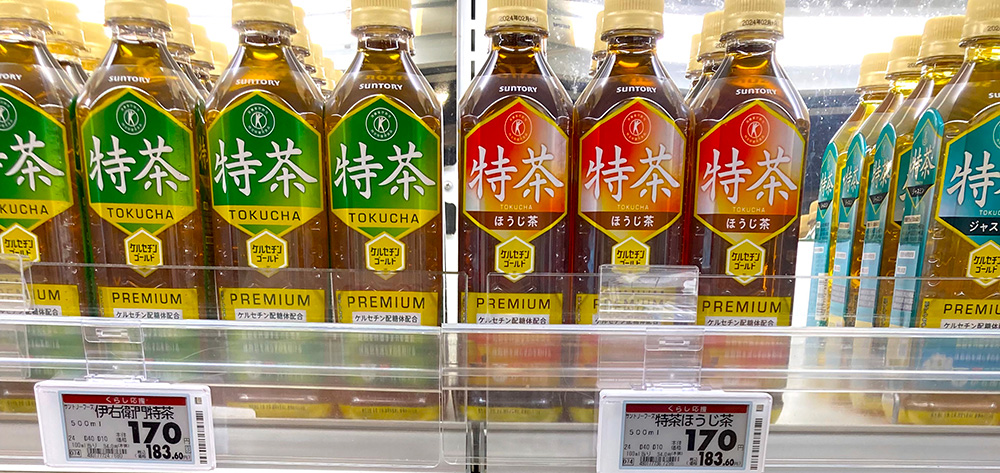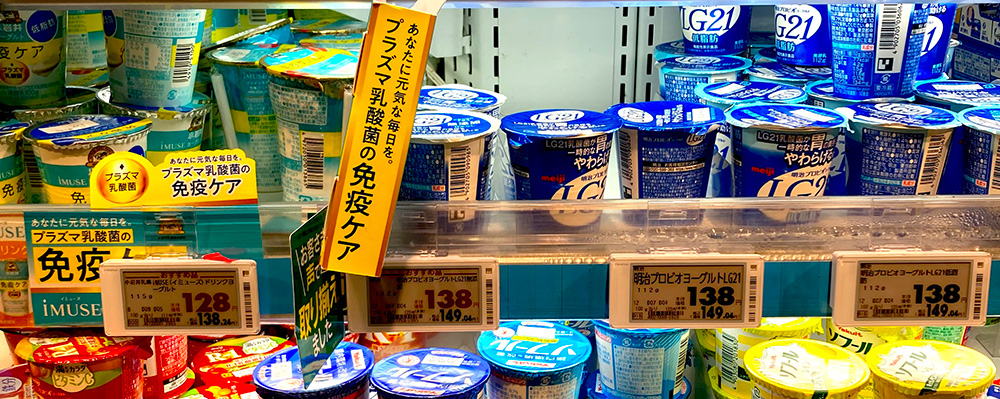In recent years, Japan has witnessed a remarkable rise in health and wellness trends among its food and drink products, captivating the hearts of health-conscious consumers. Aided by the outbreak of COVID-19 and a rapidly aging society, the quest for a healthier lifestyle, especially among younger Japanese consumers, has driven people to seek less processed food and more natural alternatives for their daily sustenance.
And there’s a diverse range of products on offer, catering to different needs. From organic and ‘free-from’ choices to naturally healthy, food intolerance, fortified and functional options, each category has experienced a surge in sales. Younger Japanese consumers are also trading a traditional lifestyle focused on work for one favouring their leisure time. And this has all created a big market for western firms with health and wellness products.
Let’s take a closer look at the flourishing landscape of mindful food choices in the Land of the Rising Sun.
How does Japan define ‘functional foods’?
Functional foods and health foods are defined by the Japanese government as those that offer health benefits beyond basic nutrition. They include a wide array of foods, beverages and ingredients from vitamins to fibers, proteins, minerals and other bioactive substances. While many are sold without specific health claims, they capitalize on the reputation of well-established Japanese brands such as Yakult Honsha and Meiji Holdings.
Foods that do make health claims, on the other hand, must be registered in one of three labeling categories established by the Ministry of Health, Labour & Welfare (MHLW) and the Japanese Consumer Affairs Agency (CAA). These categories are Food for Specified Health Use (FOSHU), Food with Nutrient Function Claims (FNFC) and Food with Function Claims (FFC). The two main categories I will discuss here are FOSHU, which requires clinical trials, and FFC, which does not.
How big is the market?
In Japan, the birthplace of the functional ingredients industry, the functional food market saw an 24% increase in 2022, reaching an impressive size of GBP 3.0 billion. And, according to Fuji Keiza – a market research company specializing in food, beverages, pharmaceuticals and cosmetics – it’s expected to grow to GBP 3.3 billion this year.
Areas to look out for
Within this large and expanding market, there are three particularly high-growth areas: fat control, stress relief and gut health.
GBP 1.7 billion of the Japanese market in 2022 was attributed to supplements with fat control claims – a striking 117% increase on the previous year. That represents 57% of the entire functional foods market!
 Fat control teas in a Japanese convenience store
Fat control teas in a Japanese convenience store
Products in this field are in high demand and many new products are being launched every year. For example, household brands like Oi Ocha (made by tea drink manufacturing giant Ito-en) and Iyemon (produced by Suntory, Japan’s top beverage maker) have been renewed with fat contol claims.
Japanese people are also becoming increasingly interested in finding products to help with stress and sleep.
And I expect to see more food products that combine multiple health claims such as stress relief, sleep benefits, sugar control, blood pressure control, gut biome enhancement, muscle strength and weight loss.
Certainly the most popular products for stress and sleep claim to address both – with purported gut microbiome improvement thrown in as well.
Yakult Honsha and Asahi Soft Drinks were responsible for expanding this market, catching the attention of consumers concerned about COVID-related stress and sleep concerns. For example, we’ve seen the launch of Yakult 1000, a probiotic lactic acid drink that contains 100 billion L. casei strain Shirota, which claims to reach the intestines alive. This product says it can help reduce stress and improve overall sleep quality, on top of improving the gut microbiome.
While, during the 2000s, the gut health market was dominated by yoghurt and lactobacillus beverages classified as Foods for Specified Health Use (FOSHU), in recent times, a diverse range of products utilizing lactobacilli has emerged under the Foods with Functional Claims (FFC) category.
I expect this trend to continue, with FFC products surpassing FOSHU items by the end of this year.
Superfoods
Japanese consumers are also interested in food ingredients and are always on the lookout for the ‘next big thing’. In 2022, the top five trending superfoods were green papaya, acerola (also known as Barbados cherry), CBD oil, Indian long peppers and rice bran.
Green papayas, hailed as the ‘king of enzymes’, offer unmatched enzyme content before ripening and have become popular in home cooking, finding their way into salads, pickles, stir-fries and smoothies.
Acerola, a vitamin C powerhouse with 34 times more than lemons, has been in high demand in the aftermath of the COVID-19 pandemic, supporting the immune system with its high polyphenol levels. Japanese restaurants are embracing it in various dishes including ramen noodles and smoothies.
Another rising ingredient is CBD, extracted from the cannabis plant and sought after for its relaxation, immune system regulation and pain-alleviating effects. CBD products have seen a surge in the US and are now making their presence felt in Japan with the opening of CBD specialty stores.
Indian long peppers, a long-used spice in Oriental medicine, is valued for its pungent ingredient ‘piperine’, improving blood flow and providing body warmth.
Lastly, the concept of sustainability and ‘upcycled food’ is gaining momentum, transforming discarded food parts into value-added products to reduce waste. Rice bran, for example – rich in vitamins, minerals and dietary fiber – is being ingeniously processed into easily soluble forms, fueling demand for it as a beverage.
Navigating the challenges
While Japan’s functional foods market continues to thrive, it also presents challenges that demand careful consideration from international companies aiming to succeed in this dynamic landscape.
 Probiotics in a Japanese supermarket
Probiotics in a Japanese supermarket
One significant issue is the risk of product saturation. Single-health-claim products look likely to lose their appeal over time as consumers seek more comprehensive solutions. To stay relevant, companies must offer products with credible multiple health claims, ideally providing three to five benefits.
This approach necessitates ongoing research and development to identify the most effective and sought-after combinations.
Another market obstacle stems from the dominance of established food and beverage manufacturers in Japan. These command the trust and loyalty of Japanese consumers, making it more difficult for newer entrants to gain a foothold. To succeed, new market entrants must emphasize their unique selling points, ensuring a compelling value proposition that resonates with health-conscious Japanese consumers.
Cross-border ventures
But although entering the Japanese market has its challenges, there are certainly a wide range of opportunities in the market. For western firms, strategic partnerships with Japan’s major food and beverage companies can be a powerful approach.
Finland's Solar Foods, for example, has formed an alliance with Japanese food and biotechnology corporation Ajinomoto to develop products using Solein, a protein grown out of thin air. This partnership marks Solar Foods' first collaboration with a major global food brand, with a goal to launch a range of sustainable products globally in the coming years.
Solar Foods has received regulatory approval and plans to establish its first commercial-scale Solein production facility in Finland by 2024. Solein's unique bioprocess makes it highly sustainable and versatile for production anywhere, even in space. And, with Ajinomoto's extensive global reach and focus on green strategies, this partnership aims to revolutionize food production and promote environmental sustainability.
Investment by Japanese companies in R&D in the functional ingredients and health foods spaces is also increasing.
Japan’s Suntory Holdings, for example, has invested in Rem3dy Health, a UK startup using advanced 3D printing for personalized nutritional gummies called Nourished. The investment was driven by belief in the technology's potential for product development, along with Rem3dy Health's mission of providing convenient personalized nutrition.
Currently in the UK and US markets, Rem3dy Health plans to expand further, with Suntory aiming to globalize its products and achieve mutual growth. This investment is Suntory's first in an overseas startup, aligning with its focus on innovation and international collaboration.
Trade shows to visit
Japan hosts various important food and beverage trade shows, with Health Ingredients Japan (Hi-Japan) standing out as the largest dedicated to functional foods and health ingredients. This takes place every October at the Tokyo Big Sight venue.
Attending trade shows like Hi-Japan – whether by taking a booth or just visiting – is a key step in building your network and breaking into the Japanese market.
Likewise, Japanese companies participate in international trade shows including Food Ingredients Europe and, in the US, the IFT (Institute of Food Technology) FIRST event and the Nutrition show. These are also good opportunities to make useful business connections.
The future
So, Japan's functional foods market is thriving, fueled by health-conscious consumers seeking natural and holistic options.
The impact of COVID-19 and an aging population has intensified the quest for healthier lifestyles, driving the demand for mindful food choices. And, amidst this flourishing landscape, innovative superfoods and ingredients like green papayas, acerola and CBD have captured Japanese consumers' attention.
Still, challenges face international companies looking to succeed in Japan. Overcoming product saturation requires ingenuity, with products convincingly boasting multiple health claims emerging as the most promising options. And new players need to stand out with compelling value propositions.
Above all, functional food businesses wanting to break into Japan’s competitive market must demonstrate adaptability, innovation and a deep understanding of Japanese consumer preferences.
Do that well, and you can unlock the vast potential this burgeoning sector holds.
To discuss the opportunities for your functional food business in Japan, you can contact Paula at paula.dizon@intralinkgroup.com